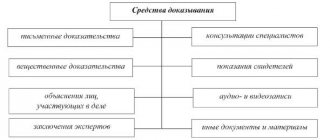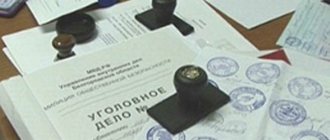Correct assessment of evidence is the most important guarantee of ensuring human and civil rights and freedoms, respecting and strengthening law and order in a democratic state governed by the rule of law. It is an indispensable observance of the principle of legality by the courts, the prosecutor's office, investigative and inquiry bodies, which excludes cases of bringing to criminal liability persons whose actions have not established the presence of a crime.
According to Part 1 of Art. 88 of the Code of Criminal Procedure of the Russian Federation “each evidence is subject to assessment from the point of view of relevance, admissibility, reliability, and all collected evidence in the aggregate - sufficiency for resolving a criminal case,” that is, information about facts can perform the functions of evidence only if they have the properties of relevance and admissibility , reliability and sufficiency .
The concept of evidence reliability
The reliability of evidence is a property of evidence expressed in the justification of its truth and characterizing it as corresponding to objective reality (true). This is the irrefutability of evidence by other evidence in the process of proof. Reliability includes objective (conformity of the evidence to reality) and subjective (internal conviction of the inquirer, investigator, prosecutor, court of the truth of the evidence, i.e. its validity) moments.
Reliability is intended to confirm the correspondence of facts to reality, as well as the reliability of their sources. Reliable evidence is the one whose veracity is beyond doubt.
Thus, the judicial panel for criminal cases of the Supreme Court of the Russian Federation determined that the acquittal in relation to Shch., S. and V. was subject to cancellation. Acquitting them of non-involvement in the commission of a crime under Part 2 of Art. 167 of the Criminal Code of the Russian Federation, the Kostroma Regional Court referred to the unknown cause of significant damage to the house by arson. Assessing the available evidence, the court indicated that the administration of the municipal district, which assessed the house, is not a special organization with the authority to evaluate real estate, and the assessment of damage to victims K. is subjective. Meanwhile, according to the requirements of Part 1 of Art. 88 of the Code of Criminal Procedure of the Russian Federation, each evidence is subject to assessment from the point of view of relevance, admissibility, reliability, and all collected evidence in the aggregate - sufficiency for resolving a criminal case. The court did not evaluate the letter from the administration and the testimony of the victim K. from the point of view of reliability. The grounds given in the verdict do not in themselves indicate the unreliability of the information about the value of the house contained in the evidence reviewed. The correctness of this information was subject to verification in accordance with the provisions of Art. 87 of the Code of Criminal Procedure of the Russian Federation, and only after that it was possible to draw a conclusion about the presence or absence of significant damage. The court did not carry out such a check; the examined evidence was not recognized as unreliable or inadmissible, and therefore the conclusion about the lack of data on the significance of the damage caused cannot be considered justified. Therefore, the verdict of the Kostroma Regional Court regarding the acquittal of Shch., S. and V. under Part 2 of Art. 167 of the Criminal Code of the Russian Federation was repealed and the criminal case was sent for a new trial.
General definition
In order not to make mistakes with the selection, analysis, and consolidation of important arguments in criminal proceedings, it is necessary to constantly systematize and improve working methods.
Legal science has not yet come to a clear opinion on a clear criterion for separating evidence into direct and indirect. The line is extremely thin, but important; the method of accounting and assessment during the investigation depends on it.
The official concept is clearly formulated by Article 74 of the Criminal Procedure Code of the Russian Federation (similar definitions are given by civil and arbitration procedural law). It follows from it that direct and indirect evidence in criminal proceedings is all kinds of data that help the investigative authorities identify circumstances that are subject to proof or refutation or are of value for the investigation.
List of their sources:
- Suspects, accused (confession, sincere repentance, information during interrogations, confrontations, investigative experiments, other procedural events).
- Citizen-witnesses (story about details, details, guesses that have become known to them).
- Persons (individuals, legal entities) recognized as victims or legal representatives.
- Conclusions based on the results of the examination.
- An expert's opinion obtained during a formal interrogation.
- Professional opinion of a specialist.
- Materialized evidence (objects, valuables, money).
- Recorded investigative and judicial actions.
- Other documents.
It is clear from the definition that the legislator introduces an unlimited list, without dividing it into direct, indirect, important, and secondary groups.
But the processes of a comprehensive assessment of several irrefutable facts and a set of data that are subject to additional verification require nuances. Therefore, practice has developed the classification.
Assessing the reliability of evidence
Unlike other properties, the reliability of each evidence is always determined at the final stage of proof, by directly or indirectly confirming it based on their entirety.
Credibility assessment is an ongoing process that ends when final conclusions are drawn about the case based on the totality of the evidence collected. Assessment of the reliability of evidence consists of:
1) studying sources of information, their properties (for example, an assessment of a witness, an expert from the point of view of his ability to give truthful and complete testimony (conclusions) - interest or disinterest, the state of hearing or vision of the witness, the qualifications of the expert, or an assessment of the nature and conditions of discovery of the material carrier (object, document));
2) studying the methods and circumstances of obtaining information by the source (under what circumstances the witness observed the established event, what methods the expert used, etc.);
3) analysis of the content of information (consistency and completeness of presentation, presence of contradictions, inaccuracies, gaps, validity of conclusions);
4) comparison of information obtained from this procedural source with information obtained from other procedural sources.
Assessing credibility requires each time making judgments about how reliable each piece of evidence is; what fact is relevant to the case, and how accurately it establishes or refutes it; what is its relationship with other evidence; What significance does the entire body of evidence have for the case?
Obtaining reliable knowledge is a process of transforming probable knowledge into reliable knowledge, since in proving any knowledge usually appears at first as probable and problematic. Probability means approximate knowledge, partial, incomplete validity of a statement. Probable knowledge requires further justification and therefore causes the subject of assessment a certain degree of confidence in the truth of this knowledge.
For example, if a witness is not interested in the outcome of a criminal case, then this, with some degree of probability, indicates the truth of the evidentiary information. And if the witness is interested in the outcome of the case, the degree of probability decreases. An interested witness or an inexperienced expert may provide truthful information, but this is less likely. The concept of probability can be presented in the form of objective probability, associated with the relative frequencies of occurrence in mass phenomena, and subjective probability, which represents the degree of confidence of the subject in the event.
Classification and functions
The distribution of the data array into categories is conditional and vaguely established by law. There is no unanimous agreement on this matter among scientific theories, since any statement can simultaneously play the role of direct and indirect. And the range of circumstances that are important for establishing the truth is influenced by the subjective factor - the opinion of the investigator, the court.
The most common classification:
- direct - directly indicate the circumstances that need to be proven (for example, a thief comes to confess to the police or the victim talks about who committed the robbery);
- indirect - indicate circumstances that took place before, during and after the event under study. The totality gives grounds to draw specific conclusions about the reality of the offense, the guilt of the suspect, the accused.
The method of developing, verifying, proving or disproving versions based on this information is more time-consuming, complex, requiring significant experience and prudence.
Indirect arguments greatly influence a criminal case:
- extremely important for testing direct evidence;
- often help to establish the motive - the subjective side of the composition, which is the connecting link of the entire complex of collected arguments;
- inform about the intent, psychological portrait of the attacker, and the presence of accomplices;
- fill gaps in versions;
- open ways to attract new information;
- especially affect the disclosure of some complex offenses (bribery, abuse of power, theft, etc.);
- indicate the attitude of the criminal to the crime committed (behavior: desire to mislead law enforcement agencies or, conversely, repentance);
- play a role in crime prevention by establishing the prerequisites underlying them.
During the investigation, depending on the subject of proof, the status of evidence may naturally change.
For example, the presence of a sum in the hands of a citizen at a certain moment can directly prove the giving of a bribe, but indirectly allow an attempt to receive a bribe. We have to admit that indirect arguments are most often significant for establishing guilt.
The relationship between reliability and admissibility
The question of the reliability of evidence is unthinkable without determining the relationship between reliability and admissibility. In the theory of evidence of the late 19th century, there was a widespread position according to which unreliable evidence was unacceptable, i.e., in fact, reliability was considered as a criterion of admissibility. Now, inadmissible evidence can be either reliable or unreliable. A conclusion about admissibility precedes a conclusion about reliability, but does not replace it. Thus, admissibility and reliability are intersecting concepts.
Many admissibility rules are designed to guarantee and maximize the reliability of evidence. This may include, for example, the requirement to obtain evidence from strictly defined sources; inadmissibility of testimony from a witness who cannot indicate the source of his knowledge; inadmissibility of the conclusion of an expert interested in the outcome of the case; requirement for the presence of witnesses during investigative actions and many others.
Evidence is considered inadmissible because irremovable doubts arise about its reliability. The admissibility requirements are clearly formalized, and therefore the question of recognizing evidence as admissible or inadmissible is decided unambiguously and is not subject to further assessment, unlike reliability.
Detection
To detect, to record - for this it is necessary to take very seriously the collection of data on each element of the composition: object, objective side, subject, subjective side.
Wherein:
- the information must be complete and leave no room for doubt;
- any contradictory arguments or “gaps” may serve as a signal for the need to obtain additional indirect evidence that will confirm or refute the version.
The connection between indirect information and the subject of proof is ambiguous and always contains an assumption. Classic examples of circumstantial evidence in criminal proceedings, to which law enforcement agencies do not pay enough attention, are mentioned in the film “The Meeting Place Cannot Be Changed.” Here the suspect Gruzdev reports that he has branded cartridges for his own personalized pistol, from which a woman was killed. He asks the question: “Why, when committing a deliberate crime, use random cartridges that can misfire?”
The presence of branded cartridges in itself does not disprove guilt, but provides a significant reason for constructing and testing other versions. However, this information initially does not receive close attention from detectives.







